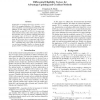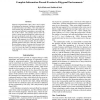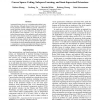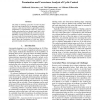AAAI
2011
12 years 11 months ago
2011
Recognizing possibly thousands of objects is a crucial capability for an autonomous agent to understand and interact with everyday environments. Practical object recognition comes...
AAAI
2011
12 years 11 months ago
2011
In this paper we propose differential eligibility vectors (DEV) for temporal-difference (TD) learning, a new class of eligibility vectors designed to bring out the contribution of...
AAAI
2011
12 years 11 months ago
2011
Suppose an unpredictable evader is free to move around in a polygonal environment of arbitrary complexity that is under full camera surveillance. How many pursuers, each with the ...
AAAI
2011
12 years 11 months ago
2011
Information about the spread of crop disease is vital in developing countries, and as a result the governments of such countries devote scarce resources to gathering such data. Un...
AAAI
2011
12 years 11 months ago
2011
Many algorithms for performing inference in graphical models have complexity that is exponential in the treewidth - a parameter of the underlying graph structure. Computing the (m...
AAAI
2011
12 years 11 months ago
2011
Automated feature discovery is a fundamental problem in machine learning. Although classical feature discovery methods do not guarantee optimal solutions in general, it has been r...
AAAI
2011
12 years 11 months ago
2011
Freuder and Elfe (1996) introduced Neighborhood Inverse Consistency (NIC) for binary CSPs. In this paper, we introduce RNIC, the extension of NIC to nonbinary CSPs, and describe a...
AAAI
2011
12 years 11 months ago
2011
The utility of including cyclic flow of control in plans has been long recognized by the planning community. Loops in a plan increase both its applicability and the compactness o...
AAAI
2011
12 years 11 months ago
2011
This paper addresses the task of trajectory cost prediction, a new learning task for trajectories. The goal of this task is to predict the cost for an arbitrary (possibly unknown)...
AAAI
2011
12 years 11 months ago
2011
Important ecological phenomena are often observed indirectly. Consequently, probabilistic latent variable models provide an important tool, because they can include explicit model...




